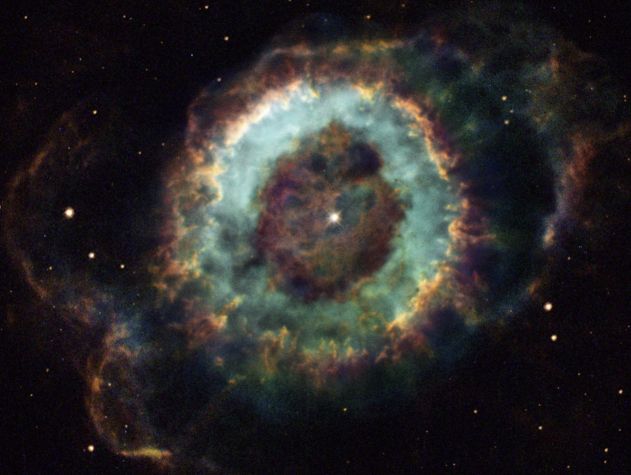Credit & Copyright: Hubble Heritage Team,
NASA
Explanation:
This pretty planetary nebula, cataloged as
NGC 6369, was discovered
by 18th century astronomer
William Herschel as he used a
telescope to explore the medicinal constellation
Ophiucus.
Round and planet-shaped, the nebula
is also relatively
faint
and has acquired the popular moniker of
Little Ghost Nebula.
Planetary
nebulae in general are
not at all related to planets,
but instead are created at the end of a sun-like star's life as its
outer layers expand
into space while the star's core shrinks to become
a white dwarf.
The transformed white dwarf star,
seen near the center,
radiates strongly at ultraviolet wavelengths and powers the expanding
nebula's glow.
Surprisingly complex
details
and structures of NGC 6369 are revealed in this
delightful
color image composed from Hubble Space Telescope
data.
The nebula's main ring structure is about a light-year across and
the glow from ionized oxygen, hydrogen, and nitrogen atoms
are colored
blue, green, and red respectively.
Over 2,000 light-years away, the
Little Ghost Nebula offers a glimpse
of the fate of our Sun, which should produce its own pretty planetary
nebula only about 5 billion years from now.
1999 2000 2001 2002 2003 2004 2005 2006 2007 2008 2009 2010 2011 2012 2013 2014 2015 2016 2017 2018 2019 2020 2021 2022 2023 2024 2025 |
Yanvar' Fevral' Mart Aprel' Mai Iyun' Iyul' Avgust Sentyabr' Oktyabr' Noyabr' Dekabr' |
NASA Web Site Statements, Warnings, and Disclaimers
NASA Official: Jay Norris. Specific rights apply.
A service of: LHEA at NASA / GSFC
& Michigan Tech. U.
|
Publikacii s klyuchevymi slovami:
NGC 6369 - planetary nebula - Herschel - Planetarnaya tumannost' - Gershel'
Publikacii so slovami: NGC 6369 - planetary nebula - Herschel - Planetarnaya tumannost' - Gershel' | |
Sm. takzhe:
Vse publikacii na tu zhe temu >> | |
